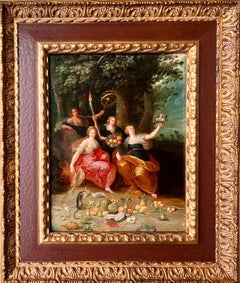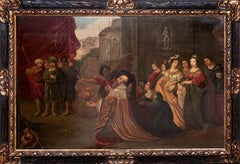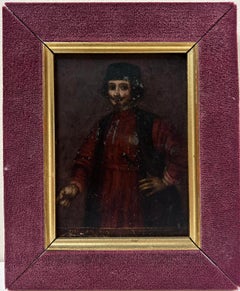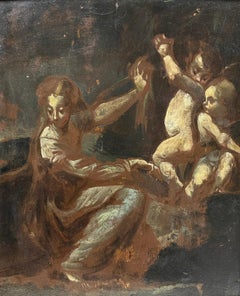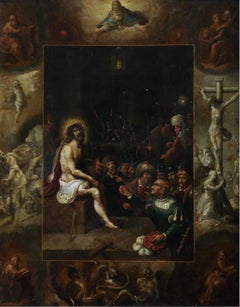Frans Francken II Art
to
2
2
1
1
1
1
Overall Height
to
Overall Width
to
1
1
1
1
1
2
2
6,996
3,348
2,513
1,213
2
2
2
1
Artist: Frans Francken II
17th century Allegory of the four Elements - Frans Francken the Younger Flemish
By Frans Francken II
Located in Antwerp, BE
Very fine 17th century Flemish old master "Allegory of the four elements" attributed to Frans Francken the Younger
The figures are the Nereid Amphitrite, holding a coral and represe...
Category
17th Century Old Masters Frans Francken II Art
Materials
Oil, Panel
King Solomon Worshipping The Idols, 17th Century FRANS FRANCKEN II (1581-1642)
By Frans Francken II
Located in Blackwater, GB
King Solomon Worshipping The Idols, 17th Century
FRANS FRANCKEN II (1581-1642) - signed sales to $6,000,000
Large 17th Century biblical account of King Solomon worshipping the Idols, oil on panel Frans Francken. Excellent quality and condition Old Testament biblical scene on a cradled panel depicting the Idolatry of Solomon, son and successor of King David. Exceptional detail and would be enhanced with a light clean. Presented in an antique period frame. Signed.
Measurements: 47" x 34" framed approx
Artist Biography
Frans Francken II or the Younger is the third in order of descent in the Francken family tree. Born in 1581, the son of Frans Francken I or the Elder, he was the brother of Thomas, born in 1574, of Hieronymous II, born in 1578 and died in 1623, and of Ambrosius II, the last in line, who died in 1632. Hieronymous II, who died at the age of 56, is only known for his painting Horatius Cocles at Sublicius Bridge. Frans the Younger was initially a pupil of his father, who was then at the height of his career. In his father's studio he imbibed all the teaching of the tradition of Frans Floris. He also spent long periods in Italy, where he familiarised himself in particular with the masters of the Venetian school. Such study in situ enabled him to break away from the well-worn methods of Flemish Italianism, as practised by his father and uncles. It is conceivable that the young artist met Rubens, who was in Italy at the time.
In 1605, at the age of 24, on his return to Antwerp, Frans the Younger became a master in the Antwerp Guild of St Luke. In 1607 he married Elisabeth Placquet in Antwerp. Three sons and eight daughters resulted from this marriage. His children made up the fourth generation in the dynasty. Better known are Frans III (1607-1667) and Hieronymus, born in 1611. The latter had a son, Constantinus (1661-1717), who marks the end of the line. The family of Francken painters runs from 1520 to 1717.
As one of the most active masters in Antwerp, Frans II was appointed dean of the guild in 1614. He was also a member of the Violette, a major literary association, for which he painted an award-winning symbolic coat of arms. He was intimate with the most celebrated artists, in particular van Dyck, who executed a very fine portrait of him, judging by the engraving by Willem Hondius and Pieter de Jode. It is also likely that he was on familiar terms with Rubens who was his near contemporary. He died in Antwerp on 6 May 1642 at the age of 61, outlived by both Rubens and van Dyck.
The first securely dated work of Frans the Younger is Christ on the Cross from the gallery in Vienna, painted in 1606. Witches' Sabbath (Vienna) and The Works of Mercy (Antwerp) are dated 1607 and 1608 respectively. In these two latter works the painter proves himself adept at painting figures and allegorical scenes. The Works of Mercy represents various groups of figures, symbolising the different activities inspired by Christian charity. Paupers and beggars occupy the foreground, the ensemble being dominated by the figure of the glorious Christ.
While Frans the Younger cannot be compared with the masters of this great first generation of Antwerp, which was illuminated and steered by the genius of Rubens, he does nevertheless merit attention. He succeeded in developing and bringing into fashion an anecdotal genre on a more modest scale, elements of which were to inform the last representatives of the Francken family for over a century. Frans the Younger was undoubtedly the most talented draughtsman in the family. While his art may be criticised for its lack of grandeur and solemnity, the execution shows great talent. His brush stroke was vigorous and his imagination, albeit restrained, was brilliant. His interest in tonal values was highlighted by his study and appreciation of his remarkable contemporaries. This enabled him to carry out landscapes and also fleshy figures, which made him altogether worthy of the brilliant period to which he belonged. While detail certainly preoccupied him, he treated it with intelligence and even esprit, as witnessed in The Parable of the Prodigal Son and A Prince's Visit to the Treasury of a Church(both in the Louvre). The scenes painted in grisaille, which surround the principal motif of the Prodigal Son, are characteristic of his style. He excelled in painting jewellery, ornaments, and textiles with shot silk effects. A large number of his figures inhabit the neutral backgrounds of the interiors of apartments and galleries. He carried out such work not only under his own auspices, but also for other artists, such as Peeter Neeffs, van Bassen, Josse de Momper...
Category
17th Century Frans Francken II Art
Materials
Wood Panel, Oil
Related Items
Italian 18th Century Oil Painting Portrait of a Merchant
Located in Cirencester, Gloucestershire
A Venetian Gentleman
18th Century Venetian School
oil painting on board, framed
framed: 7.25 x 6 inches
board: 5.25 x 4 inches
provenance: private collection, UK
condition: sound bu...
Category
18th Century Old Masters Frans Francken II Art
Materials
Oil
Angelic Cherubs with Classical Figure in Wilderness Finely Painted Preparatory
Located in Cirencester, Gloucestershire
Figure with Cherubim in Wilderness
Italian School, 17th century
oil painting on wood panel
framed 13 x 11 inches
condition: overall for its age very good, though the work is most likely a preparatory...
Category
17th Century Old Masters Frans Francken II Art
Materials
Wood Panel, Oil
17th Century French School, Saint John the Baptist, oil on copper
Located in Paris, FR
17th Century French School
Saint John the Baptist in a landscape
oil on copper
17 x 11.5 cm
In good condition except very small loss of painting in the lower left part
In a modern f...
Category
1680s Old Masters Frans Francken II Art
Materials
Oil
The Virgin in Adoration - 17th Century Italian Old Master Religious Oil Painting
Located in Sevenoaks, GB
A beautiful late 17th century Italian Old Master oil on canvas depicting The Virgin in Adoration, circle of Carlo Maratta.
Excellent quality early Italian work, presented in an ant...
Category
17th Century Old Masters Frans Francken II Art
Materials
Canvas, Oil
Free Shipping
H 21.26 in W 18.12 in
18th Century French Portrait of Mysterious Man Oil on Canvas for restoration
Located in Cirencester, Gloucestershire
Portrait of a Gentleman
French School, 18th century
oil on canvas, unframed
canvas : 25 x 20 inches
provenance: private collection, France
condition: the painting is in sound conditi...
Category
18th Century Old Masters Frans Francken II Art
Materials
Oil
18th century Portrait of a young girl, Miss Cator in a landscape, white dress
By John Russell
Located in Woodbury, CT
Portrait of a young British Girl, in her white dress with Pink Sash.
Choosing to acquire an 18th-century portrait of a young girl by English artist John Russell is an opportunity to...
Category
1780s Old Masters Frans Francken II Art
Materials
Canvas, Oil
Free Shipping
H 21 in W 18 in
Fine 18th Century English Aristocratic Portrait of a Lady Oval Canvas Gilt Frame
Located in Cirencester, Gloucestershire
Artist/ School: English School, circa 1740's
Title: Portrait of a Lady, traditionally identified as 'Anne of Chesterfield'.
Medium: oil painting on canvas, framed
Size: painting: ...
Category
Early 18th Century Old Masters Frans Francken II Art
Materials
Canvas, Oil
John Hervey Portrait on occasion of receiving the Title 1st Earl of Bristol
By (Circle of) Godfrey Kneller
Located in Firenze, IT
Portrait of John Hervey, 1st Earl of Bristol (1665-1751).
Early 18th-century near-life-size portrait of a noble man richly dressed in a long wig.
Circle of the German-British cour...
Category
Early 18th Century Old Masters Frans Francken II Art
Materials
Oil, Canvas
H 66.93 in W 53.15 in D 1.58 in
Portrait Gentleman Black Coat Orange Sash, Dutch Old Master, Oil on Panel c.1650
By Bartholomeus van der Helst
Located in London, GB
This exquisite portrait of a gentleman depicted in a sumptuous black coat edged with silver and slashed sleeves is an excellent example of the type of portrait fashionable in England and the Low Countries during the 17th century. The confident pose, striking orange sash - the colour of the house of Orange Nassau - and the leather gorget imbue the sitter with a sense of masculinity and power. The profusely decorated costume is of the highest quality and de rigueur of an elite class - the artist has carefully cultivated this portrait to emphasise the sitter’s wealth and standing in the society that he belonged to. The casual pose, with one arm resting on a hip, is much less formal than earlier decades, and it speaks of ‘sprezzatura’ – one’s appearance should not appear laborious, but instead, effortless.
The oil on cradled panel portrait can be dated to circa 1650 based on the hairstyle and the attire - small falling collar, short doublet (doublets reduced in size to just below the ribcage in the late 1650’s), and the type of slashed sleeves with the sleeve seams left open to reveal the white fabric.
The demand for portraits in the Netherlands was great in the 17th century. Bartholemeus van der Helst was considered to be one of the leading portrait painters of the Dutch Golden Age surpassing even Rembrandt as the most sought-after portraitist in Harlaam. The Dutch Golden Age, roughly spanning the 17th century, was a period when Dutch trade, science, military, and art were among the most acclaimed in the world. Dutch explorers charted new territory and settled abroad. Trade by the Dutch East-India Company thrived, and war heroes from the naval battles were decorated and became national heroes. During this time, The Dutch Old Masters began to prevail in the art world, creating a depth of realistic portraits of people and life in the area that has hardly been surpassed. The Golden Age painters depicted the scenes that their discerning new middle-class patrons wanted to see. This new wealth from merchant activities and exploration combined with a lack of church patronage, shifted art subjects away from biblical genres. Still life’s of items of everyday objects, landscapes, and seascapes reflecting the naval and trade power that the Republic enjoyed were popular. The new wealthy class were keen to have their portraits commissioned and many artists worked in this lucrative field. Such was the popularity of art that everyone had a painting, even the humble butcher, and hundreds of thousands of paintings were produced.
By tradition the sitter is Maarten Tromp (1598-1653) who was an Admiral in the Dutch Navy (the reverse of the portrait contains an old handwritten inscription “van Tromp”). Certainly, the distinctive orange sash is similar to those worn by officers of the Dutch army in the Netherlands who served under the Princes of Orange and the House of Nassau. However, it should be noted that the physiognomy differs from other images of Tromp.
Tromp was the oldest son of Harpert Maertensz, a naval officer and captain. He joined the Dutch navy as a lieutenant in July 1622 and was later promoted from captain to Lieutenant-Admiral of Holland and West Frisia in 1637. In 1639, during the Dutch struggle for independence from Spain, Tromp defeated a large Spanish fleet bound for Flanders at the Battle of the Downs, which marked an enormous change - the end of Spanish naval power. He was killed in action during the First Anglo-Dutch War in 1653 where he commanded the Dutch fleet in the battle of Scheveningen.
Gloves were an absolutely vital accessory and the elaborate pair in this portrait are embellished with threads of silk and precious metals and salmon-coloured lining. He wears only one glove and holds the other, providing an opportunity to better display the cuffs and detail on his right wrist and forearm. The gloves are probably made from the most prized leather which came from Spain, in particular from Cordova. Cordovan leather was tanned with a special vegetal process that left it both highly impermeable and divinely soft. King Charles I, posed in a rather relaxed manner for Daniel Mytens’s portrait in 1631, is wearing gloves and boots in matching Cordovan leather. The hide is thick, but you can see just how supple it is from the way the gauntlet dimples and the long boot legs fold over themselves, rippling and wrinkling at the ankles.
Apart from keeping hands warm the use of gloves during the 15th through the 19th centuries were full of symbolism and they were worn regardless of the season. They kept the skin unblemished - soft, smooth hands were considered highly attractive. This combination of necessity and proximity to bare skin made gloves a deeply personal gift and they took on a strong symbolic significance and were regarded as emblematic of fidelity and loyalty for hundreds of years. Such was the importance of their symbolism was that some gloves were never intended to be worn at all. Their luxury made them ideal gifts at court, and so in the 15th and 16th centuries, ambassadors often presented them as symbols of loyalty.
Until the mid-19th century, it was customary to give gloves as tokens to guests at weddings and to mourners at funerals. Gentleman often gifted their bride-to-be with a pair of gloves (the obligatory gift) and were handed over at the betrothal and put on display before the wedding took place. It was probably their direct contact with the skin that led to the eroticism of gloves. Not only were pairs often exchanged between lovers, but from the 16th to the 18th centuries, it was common practice to remove one glove and give it as a gift to a favourite. The idea of the item being presented still warm from the wearer’s hand is certainly suggestive. Following the death of King George IV, his executors purportedly found over a thousand mismatched ladies’ gloves among his possessions.
The sentiment of a 17th-century poem reveals the popularity of the practice: “Come to our wedding to requite your loves / Shew us your hands and we’ll fit you with gloves.” Such generosity might be pricey for the hosts, but gloves of varying quality could be offered depending on the status of the recipient. Pairs made with the finest Spanish leather might be reserved for immediate family, while coarse sheep’s leather could be distributed among the servants and tradesmen. The apportioning of quality according to class provided a very clear message of the gloves’ intended use. For refined guests, they were decoration; for the lower classes, they were functional.
Bartholomeus van der Helst...
Category
17th Century Old Masters Frans Francken II Art
Materials
Oil, Wood Panel
H 38.59 in W 31.89 in D 2.76 in
The Card Players by a Flemish 1600s Artist
By Flemish School, 17th Century
Located in Stockholm, SE
Flemish 1600s School
The Card Players
oil on oak panel
panel dimensions 22.5 x 20 cm
frame included
Provenance:
From a Swedish private collection.
Condition:
Flat and stabl...
Category
17th Century Old Masters Frans Francken II Art
Materials
Oak, Oil, Panel
Fine Dutch Old Master Large Oil Painting Portrait Gentleman in Ruff Collar Robes
Located in Cirencester, Gloucestershire
Portrait of a Gentleman in Ruff Collar and Robes
Dutch School, 18th century
oil on canvas laid over panel, unframed
board: 28.5 x 24 inches
provenance: private collection
condition: ...
Category
Mid-20th Century Old Masters Frans Francken II Art
Materials
Oil
Mary & Jesus, 18th Century French Old Master oil painting on canvas
Located in Cirencester, Gloucestershire
Artist/ School: French School, 18th century
Title: Mary and Jesus
Medium: oil on canvas, framed
Framed: 17 x 14.5 inches
Canvas: 16 x 12.75 inches
Provenance: private collection...
Category
18th Century Old Masters Frans Francken II Art
Materials
Oil
Previously Available Items
Adoration Paint Oil on table 16th century Art Baroque Manierism
By Frans Francken II
Located in Riva del Garda, IT
Workshop Frans Francken II (Antwerp 1581 - 1642)
Adoration of the Magi
School of Antwerp in the second half of the sixteenth century
oil on panel, parquet floor
Dimensions (cm): 48 x 63, with frame (from the 19th century) 61 x 76
The proposed painting represents the scene of Adoration of the Magi, a favorite theme of ancient painting. Considerable importance is attributed to the figures of the three wise men, sumptuously dressed; the richness of their clothes contrasts with the humility of the Holy Family, on the right, and the other characters who watch the scene with curiosity. The representation is based on a traditional iconography, where the wise kings symbolize, with the gift brought to Jesus, the three parts of the world known at the time: Africa, Asia and Europe. Melchior, the eldest, is kneeling in adoration of the child, offering him gold, in recognition of his kingship; Gasparre, wearing a turban crown, offers incense, a sign of the divinity of Jesus, while Baltassarre, the black king, offers myrrh, symbol of his sacrifice for our salvation. Of obvious Flemish origin, the work is part of the production of the Antwerp School at the end of the 16th century; in particular, it is due to the prolific workshop Francken, the famous family of painters from Antwerp who played a predominant role in local art for four generations. In particular, the characters of style and composition bring the paternity of a painter close to Frans Francken II (Antwerp 1581-1642), with some points of contact with his son, Frans Francken III...
Category
17th Century Old Masters Frans Francken II Art
Materials
Oil
H 24.02 in W 29.93 in
The Mocking of Christ
By Frans Francken II
Located in Marlow, Buckinghamshire
Description:
The Mocking of Christ surrounded by four vignettes depicting The Crucifixion (right side) The Resurrection (left side), Hades (lower centre) and God (upper centre
Prov...
Category
Early 17th Century Old Masters Frans Francken II Art
Materials
Copper
Frans Francken Ii art for sale on 1stDibs.
Find a wide variety of authentic Frans Francken Ii art available for sale on 1stDibs.
